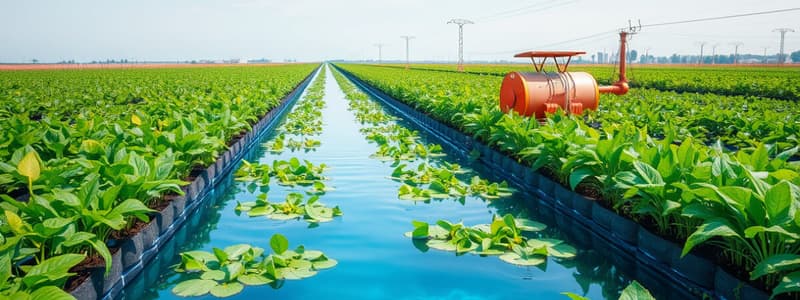Podcast
Questions and Answers
What distinguishes grey water from other types of water?
What distinguishes grey water from other types of water?
- It consists of rainwater stored in the soil.
- It is the water that recharges groundwater aquifers.
- It includes water from sinks and showers without faecal contamination. (correct)
- It is the water used solely for irrigation purposes.
How is the energy efficiency ratio defined in agricultural systems?
How is the energy efficiency ratio defined in agricultural systems?
- The comparison of energy derived from crops versus livestock.
- The amount of energy used per unit area of farmland.
- The ratio of energy output in food to energy input for food production. (correct)
- The total energy consumption of a farm divided by energy lost.
Which term describes the precipitation that is stored in soil and on vegetation but does not contribute to surface runoff?
Which term describes the precipitation that is stored in soil and on vegetation but does not contribute to surface runoff?
- Energy-efficient water
- Grey water
- Blue water
- Green water (correct)
What is the primary concept behind the systems approach in agricultural studies?
What is the primary concept behind the systems approach in agricultural studies?
What does the term 'water footprint' represent?
What does the term 'water footprint' represent?
What role does precipitation have in the farm system?
What role does precipitation have in the farm system?
How does cash flow within the farm system?
How does cash flow within the farm system?
What aspect of feed composition significantly affects the water footprint (WF) in meat production?
What aspect of feed composition significantly affects the water footprint (WF) in meat production?
Which of the following best describes the connection between solar energy and farming practices?
Which of the following best describes the connection between solar energy and farming practices?
How does industrial farming primarily reduce the water footprint for meat production?
How does industrial farming primarily reduce the water footprint for meat production?
What is the primary purpose of labor in the farming system?
What is the primary purpose of labor in the farming system?
Which of the following is NOT a component of the water footprint (WF) of meat?
Which of the following is NOT a component of the water footprint (WF) of meat?
In what way do farming practices influence waste products?
In what way do farming practices influence waste products?
What is a major factor that can lead to higher blue and grey WFs in cattle farming?
What is a major factor that can lead to higher blue and grey WFs in cattle farming?
Which component acts as the central hub in the farm system?
Which component acts as the central hub in the farm system?
What is the primary output of the farm system?
What is the primary output of the farm system?
Why does beef production generally have a larger total water footprint than poultry?
Why does beef production generally have a larger total water footprint than poultry?
How does moisture from streams and groundwater interact with farming practices?
How does moisture from streams and groundwater interact with farming practices?
Which country is likely to have a higher green water footprint due to its reliance on rain-fed agriculture?
Which country is likely to have a higher green water footprint due to its reliance on rain-fed agriculture?
What is a consequence of waste products on soil and natural vegetation?
What is a consequence of waste products on soil and natural vegetation?
How does the origin of feed affect the water footprint of meat production?
How does the origin of feed affect the water footprint of meat production?
What environmental consequence can high blue and grey water footprints in industrial farming lead to?
What environmental consequence can high blue and grey water footprints in industrial farming lead to?
Which factor significantly drives the water footprint of meat production?
Which factor significantly drives the water footprint of meat production?
What does the term 'moisture by evaporation and drainage' refer to?
What does the term 'moisture by evaporation and drainage' refer to?
What distinguishes the blue water footprint from the green water footprint?
What distinguishes the blue water footprint from the green water footprint?
How do social values and technology influence farming practices?
How do social values and technology influence farming practices?
Which of the following factors contributes to a higher total water footprint of pork compared to poultry?
Which of the following factors contributes to a higher total water footprint of pork compared to poultry?
What is the relationship between capital equipment and farming practices?
What is the relationship between capital equipment and farming practices?
In which type of farming is the water footprint expected to increase due to the greater use of concentrated feeds?
In which type of farming is the water footprint expected to increase due to the greater use of concentrated feeds?
Which of the following statements best describes the economic implications of water use in different farming systems?
Which of the following statements best describes the economic implications of water use in different farming systems?
Why is energy efficiency lower in beef production compared to plant-based foods?
Why is energy efficiency lower in beef production compared to plant-based foods?
What leads to higher water footprints in pork production in countries with irrigation-intensive practices?
What leads to higher water footprints in pork production in countries with irrigation-intensive practices?
Study Notes
Key Terms in Agriculture and Water Usage
- Blue Water: Fresh surface and groundwater found in lakes, rivers, and aquifers, vital for agricultural irrigation.
- Green Water: Precipitation that infiltrates the soil, stored temporarily, crucial for crop growth.
- Grey Water: Domestic wastewater from sinks, showers, and washing machines that doesn't contain faecal matter.
- Energy Efficiency Ratio: Compares energy output (food produced) to energy input (resources consumed) in agricultural systems.
- Water Footprint: Total volume of freshwater utilized to produce goods and services, encompassing diverse agricultural practices.
Farm Systems Overview
- Central Element: The farm household serves as the decision-making hub, managing resources and operations.
- Inputs: Include precipitation, moisture from streams, solar energy, labor, planting materials, cash, capital equipment, and socio-technical influences.
- Processes: Activities like farming practices, transpiration, evaporation, supplier payments, and waste management transform inputs into outputs.
- Outputs: Include farming produce (crops/livestock), income from product markets, and waste products requiring disposal.
Interconnections within the Farm System
- Precipitation: Affects soil and vegetation, essential for farming practices.
- Soil and Natural Vegetation: Influences farming produce and moisture levels through evaporation and drainage.
- Farming Practices: Directly yield farming produce and generate waste products, crucial for ecosystem balance.
- Solar Energy: Fundamental for photosynthesis, impacting farming practices and moisture transpiration.
- Labour: Essential for executing farming tasks and operations, integrated with the farm household management.
- Product Market: Receives produce from the farm, generating cash flow for expenditures on supplies and equipment.
- Waste Management: Interacts with natural vegetation through composting, recycling nutrients back into the soil.
Factors Influencing the Water Footprint of Meat Production
- Feed Conversion Efficiency: Higher in industrial systems due to concentrated feeds, leading to quicker meat production with less water use.
- Feed Composition: Affected by the ratio of grains (higher WF) to grasses (lower WF), influencing the overall water footprint.
- Feed Origin: The geographical location impacts water use; local climate and farming practices play crucial roles.
Variations in Water Footprint by Region
- Brazil: Higher green water footprint from rain-fed practices, lower blue due to less irrigation.
- China: Elevated blue and grey footprints owing to intensive irrigation, exacerbated by regional water scarcity.
- Netherlands: Utilizes efficient agricultural practices and technology, resulting in lower water footprints.
- United States: Similar efficiency as the Netherlands, but regional differences affect overall footprints.
Energy Efficiency in Food Production
- Least Energy Efficient: Beef production demands more inputs (feed, water) relative to output, resulting in high energy inefficiency.
- Most Energy Efficient: Plant-based foods (grains/vegetables) optimize energy inputs to outputs, presenting a lower energy cost for higher food yields.
Inefficiencies in Energy Usage
- Inputs: Resources include various forms of water (green, blue, grey), feedstock, labor, and energy for animal care and processing.
- Processes: Include feeding routines, animal care practices, slaughtering procedures, and processing which can lead to significant waste outputs and environmental impacts.
- Discussion: While industrial farming reduces water footprints via efficient feed utilization, it potentially increases blue and grey footprints due to the high water demands for concentrated feeds.
Studying That Suits You
Use AI to generate personalized quizzes and flashcards to suit your learning preferences.
Description
This quiz focuses on key terms related to agricultural systems, including the concepts of blue water and energy efficiency ratio. Understanding these terms is crucial for analyzing the sustainability and productivity of different agricultural methods. Test your knowledge on these important definitions and their implications.




